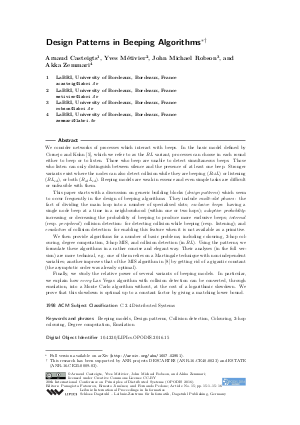Design Patterns in Beeping Algorithms
Authors Arnaud Casteigts, Yves Métivier, John Michael Robson, Akka Zemmari
-
Part of:
Volume:
20th International Conference on Principles of Distributed Systems (OPODIS 2016)
Part of: Series: Leibniz International Proceedings in Informatics (LIPIcs)
Part of: Conference: International Conference on Principles of Distributed Systems (OPODIS) - License:
 Creative Commons Attribution 3.0 Unported license
Creative Commons Attribution 3.0 Unported license
- Publication Date: 2017-04-06
File

PDF
LIPIcs.OPODIS.2016.15.pdf
- Filesize: 0.54 MB
- 16 pages
Document Identifiers
Subject Classification
Keywords
- Beeping models
- Design patterns
- Collision detection
- Colouring
- 2-hop colouring
- Degree computation
- Emulation
Metrics
- Access Statistics
-
Total Accesses (updated on a weekly basis)
0Document
0Metadata
Abstract
We consider networks of processes which interact with beeps. In the basic model defined by Cornejo and Kuhn, which we refer to as the BL variant, processes can choose in each round either to beep or to listen. Those who beep are unable to detect simultaneous beeps. Those who listen can only distinguish between silence and the presence of at least one beep. Stronger variants exist where the nodes can also detect collision while they are beeping (B_{cd}L) or listening (BL_{cd}), or both (B_{cd}L_{cd}). Beeping models are weak in essence and even simple tasks are difficult or unfeasible with them.
This paper starts with a discussion on generic building blocks (design patterns) which seem to occur frequently in the design of beeping algorithms. They include multi-slot phases: the fact of dividing the main loop into a number of specialised slots; exclusive beeps: having a single node beep at a time in a neighbourhood (within one or two hops); adaptive probability: increasing or decreasing the probability of beeping to produce more exclusive beeps; internal (resp. peripheral) collision detection: for detecting collision while beeping (resp. listening); and emulation of collision detection: for enabling this feature when it is not available as a primitive.
We then provide algorithms for a number of basic problems, including colouring, 2-hop colouring, degree computation, 2-hop MIS, and collision detection (in BL). Using the patterns, we formulate these algorithms in a rather concise and elegant way. Their analyses (in the full version) are more technical, e.g. one of them relies on a Martingale technique with non-independent variables; another improves that of the MIS algorithm (P. Jeavons et al.) by getting rid of a gigantic constant (the asymptotic order was already optimal).
Finally, we study the relative power of several variants of beeping models. In particular, we explain how every Las Vegas algorithm with collision detection can be converted, through emulation, into a Monte Carlo algorithm without, at the cost of a logarithmic slowdown. We prove that this slowdown is optimal up to a constant factor by giving a matching lower bound.
Cite As Get BibTex
Arnaud Casteigts, Yves Métivier, John Michael Robson, and Akka Zemmari. Design Patterns in Beeping Algorithms. In 20th International Conference on Principles of Distributed Systems (OPODIS 2016). Leibniz International Proceedings in Informatics (LIPIcs), Volume 70, pp. 15:1-15:16, Schloss Dagstuhl – Leibniz-Zentrum für Informatik (2017)
https://doi.org/10.4230/LIPIcs.OPODIS.2016.15
BibTex
@InProceedings{casteigts_et_al:LIPIcs.OPODIS.2016.15,
author = {Casteigts, Arnaud and M\'{e}tivier, Yves and Robson, John Michael and Zemmari, Akka},
title = {{Design Patterns in Beeping Algorithms}},
booktitle = {20th International Conference on Principles of Distributed Systems (OPODIS 2016)},
pages = {15:1--15:16},
series = {Leibniz International Proceedings in Informatics (LIPIcs)},
ISBN = {978-3-95977-031-6},
ISSN = {1868-8969},
year = {2017},
volume = {70},
editor = {Fatourou, Panagiota and Jim\'{e}nez, Ernesto and Pedone, Fernando},
publisher = {Schloss Dagstuhl -- Leibniz-Zentrum f{\"u}r Informatik},
address = {Dagstuhl, Germany},
URL = {https://drops.dagstuhl.de/entities/document/10.4230/LIPIcs.OPODIS.2016.15},
URN = {urn:nbn:de:0030-drops-70840},
doi = {10.4230/LIPIcs.OPODIS.2016.15},
annote = {Keywords: Beeping models, Design patterns, Collision detection, Colouring, 2-hop colouring, Degree computation, Emulation}
}
Author Details
References
-
Y. Afek, N. Alon, Z. Bar-Joseph, A. Cornejo, B. Haeupler, and F. Kuhn. Beeping a maximal independent set. Distributed Computing, 26(4):195-208, 2013.

-
K. Azuma. Weighted sums of certain dependent random variables. Tohoku Mathematical Journal, Second Series, 19(3):357-367, 1967.

-
A. Casteigts, Y. Métivier, J. Michael Robson, and A. Zemmari. Counting in one-hop beeping networks. CoRR, abs/1605.09516, 2016.

-
J. Collier, N. Monk, P. Maini, and J. Lewis. Pattern formation by lateral inhibition with feedback: a mathematical model of delta-notch intercellular signalling. Journal of Theoretical Biology, 183(4):429-446, 1996.

-
A. Cornejo and F. Kuhn. Deploying wireless networks with beeps. In DISC, pages 148-162, 2010.

-
S. Gilbert and C. Newport. The computational power of beeps. In Proc. of 29th International Symposium on Distributed Computing (DISC), 2015.

-
B. Huang and Th. Moscibroda. Conflict resolution and membership problem in beeping channels. In DISC, pages 314-328, 2013.

- P. Jeavons, A. Scott, and L. Xu. Feedback from nature: simple randomised distributed algorithms for maximal independent set selection and greedy colouring. Distributed Computing, 2016. URL: http://dx.doi.org/10.1007/s00446-016-0269-8.
-
S. Navlakha and Z. Bar-Joseph. Distributed information processing in biological and computational systems. Commun. ACM, 58(1):94-102, 2015.

-
J. Schneider and R. Wattenhofer. What is the use of collision detection (in wireless networks)? In DISC, pages 133-147, 2010.

-
A. Scott, P. Jeavons, and L. Xu. Feedback from nature: an optimal distributed algorithm for maximal independent set selection. In PODC, pages 147-156, 2013.

